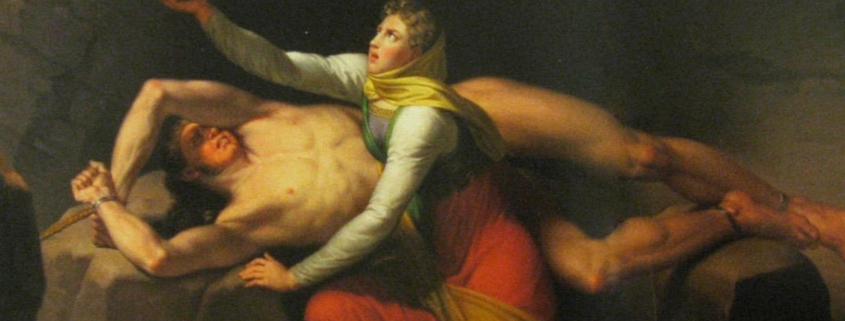MAY LOKI BE BOUND part II
By Heimgest CG
Greeting Comrades of the Rite
Following publication in the last ORB of the ‘MAY LOKI BE BOUND’ article, I received some very good feedback and questions. As it is vital for both personal growth and the advance of our Holy religion that this figure is properly understood, I think it would be helpful for all OR members to see the pertinent questions and the response.
It is likely at some point, you may be asked similar, and so the questions and the response form ‘Part two’ to the article.
Question 1.
… After the Gods have bound Loki and venomous snakes are set above him to drip poison on him, his wife Sigyn sits by him collecting the poison to stop it falling on him. What is the symbolism of this at the level the article MAY LOKI BE BOUND was on?
Heimgest’s reply
This part of the myth, like most, is rich in symbolism, from the cords used to bind (see part 1) to the ‘venomous snakes’. So much symbolism that the reply can only deal with some of it. The figure of Sigyn can be seen as rather tragic. Certainly as far as the surviving myths portray her, her only role is as Loki’s dutiful wife. This is the only reference to her and in this she is not seen as some malevolent entity, but as said, basically tragic: She, though not being malevolent, is wedded to a wholly malevolent entity. She bares this malignant force two children – neither of whom appear to bring her any joy and indeed she sees one kill the other – surely one of the greatest sorrows a mother could suffer. Moreover, it is a consequence of her ‘husband’ deeds, which leads to this tragic event, yet she still remains dutiful by him. Now at one level, some scholars including H R Ellis Davidson have noted, Sigyn could be loyal devotion. Despite the terrible sorrows visited upon her by her husband’s actions, she remains faithfully by him, serving him still, trying to protect him no matter what. Basically she sacrifices her life, her potential, to protect a serve Loki. As said, some have suggested this is symbolic of an admirable (seeming) devotion. However, at the level we are dealing with whereby the myth cycle is an illuminated path to attaining a higher awareness, we will see this not the case. We know at this level, Loki is the symbol of illusion and all humans are subject to the limitations on our potential, that illusion brings. Until Ragnarok, which is the attaining of Higher Awareness or Odin Consciousness, each and every one of us is subject, to greater or lesser degree, to illusions, limitations and sorrows. Often, if we are able to look honestly at the intentions and impulses behind our thoughts, words and deeds, we can identify where we have fallen prey to illusions, though hard to overcome, we can at least begin the process by an honest analysis of ourselves. Quite often by this, we can identify what were really negative intentions – born from selfishness, a desire to gratify our physical or emotional senses and caress the false ego or ‘little self’. At times these can be seen quite easily, though as said, still hard to overcome. But such is the truly insidious potency of illusion, that at times what can seem to be born from good (though mistaken) intentions, even misplaced compassion, is really just another illusion which holds us back from advancing.
Sigyn is symbolic of this. She is not “ill intentioned” she does not seek to act from malice or negativity, but still she is beguiled by illusion and held as its thrall. Mythologicaly her beguiling by illusion and her embrace of it – she bore two sons, the ‘fruit’ of her illusion. Like all the fruit, which comes from illusion, it is ultimately found rotten and brings only grief in the end.
Sigyn however, is unable to let go of her illusions, despite the devastating results it has wrought in her life. Unable to accept that which she has ‘given herself to’ is false, she seeks to protect her illusion at any cost, thereby chaining herself to it instead of allowing it to be dissolved. She is willing to sacrifice her own true advance in order to protect the illusion she had defined herself by. Here we see how even a noble intent if based in illusion can lead to self deception and manipulation by negative and hostile energies. We see how hard it can be to face that something we may have cherished, is in reality baneful to us and false. Instead of facing that fact, harsh though it may be, and thereby learning and benefiting, people thus illusioned refuse to face that fact. Sometimes people feel themselves defined by their attachment to something as if they themselves have no real value without it. Despite all the evidence that in reality it is harmful to them, keeps them chained, they fear to let it go, as they fear without it they have no role, no definition, no place and are truly insignificant.
In the myths we find Sigyn seems to have no existence beyond that of ‘Loki’s wife’ – if she were not to fill that role it seems she would not merit mention and is defined and apparently only of any significance because of her relation to Loki. If she were in fact to leave her illusion and allow it to be dissolved by the venom of its own deeds returning – she in fact discover her higher value, her own path to Higher awareness – but she cannot.
So we see that clinging to ‘ignorance’ (illusion being ignorance as it stops us perceiving ultimate reality), even if not from overtly self seeking motives, halts our progress to a higher awakening as surely as easily recognised self seeking intentions. At times when the bile fills her bowl and threatens to pour onto her illusion – she does leave – but such is the thrashing that creates as indeed the illusion does begin to dissolve, she hurries back to protect it again. In the myth Loki’s contractions at such times ‘shake the earth’. In other words, those who are like Sigyn cannot endure the shaking of their world they have created by illusion. Though at times they try to ‘leave’ the illusion -to let it be destroyed – they are still so attached and fearful to letting it go that they run back to it when ‘ their world’, the illusory world begins it’s disintegrations. Trust in the High gods and courage to endure what at first may seem near unbearable will stop us emulating Sigyn.
Question 2
In Lokesana it is claimed by Loki that he is Odin’s blood brother, a claim, which seems false except Odin apparently acknowledge this. Can you explain this?
Heimgest’s Reply:
Actually I’m pleased this was brought up as I had included it in my original draft for the “MAY LOKI BE BOUND” article, but cut it due to confines of space. However it is important. First Lokesana is the only one of the ‘myths’ in which this claim appears. If this claim were ‘true’, then such would be its significance that we could reasonably expect it to appear in many others. Nor is it given in Odin’s list of names. We must therefore consider if this particular myth was part of the original myth cycle. The probability that it wasn’t is further re enforced by the fact this ‘tale’ (because it is a tale rather than a myth) has been shown to be a very late addition to the myth cycle.
For those interested in such scholastic findings H R Ellis Davidson is among those who have made this known.
We know then, it was made up at a time when belief in the Gods was, at best, frail and ambiguous. TrueOdinic wisdom was virtually unknown and not revealed. Judeo- Xtianty was ascending in the Northern Odal lands, its propagandists in full flow (with state blessing) and its “thought police” in unrestrained and brutal action. A ‘skald’ that wanted to advance his career (or even remain living) would certainly not wish to present true Odinic wisdom, even if they possessed it, which seems unlikely. So this tale was composed by someone who not only almost definitely had no real belief in the ‘Gods’, but who also would have found it advantageous materially, to appeal to the ruling powers of the day.
Odinism had been so denigrated, that the Holy and Divine forces were mocked, stripped of divinity and made into the “soap operas” of the day, as noted in part 1 of this article in ORB189.
So this tale cannot be considered as part of the works containing the original ancient Indo European Odinist wisdom.
Today, it is understandable that many will want to latch onto this as a genuine teaching because so much has been destroyed or hidden, that it is almost a case of “clutching at any straw” which seems to do with our religion. But now, as we deepen our way, it is important to realise this was primarily entertainment with considerable denigration of the Holy beings thrown in.
As we know, an incoming religion, particularly a rigidly intolerant one such as Xtianity, will seek to “demonise” the previous religion. Odin was depicted as a demon figure – treacherous and given to base desire. By making the Chieftain of the Gods a “blood brother” of a negative force, it would both vilify him and undermine already weakening devotion and trust. Our ancestors took blood brotherhood very seriously, if you were thus allied, it indicated a special bond, so if Odin would ally himself with a wholly treacherous being, it would give the message, he also was treacherous. Now it maybe possible that in some lost and ancient myth – some reference was made to this blood brotherhood business, which the writer of the Lokesana had some vague knowledge of and chose to amplify. If this is so, and it is probably not likely, then the symbolism would be akin to that of Fenris (see part1). Or more specifically why Fenris is not destroyed but brought into Asgard. It would show just how insidious illusion is. Just how close it is, always at hand, even when we are consciously attempting to attain spiritual advance and it is a constant ‘threat’ to this development until the realisation of Odin Consciousness. We must always be vigilant that our thoughts and deeds are free from Loki’s energy.





